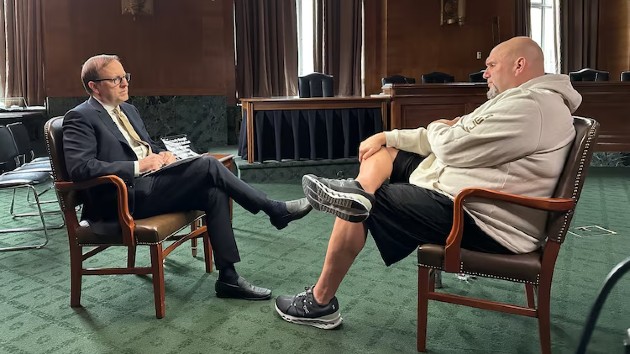Australian island draws gas prospectors seeking pot of ‘gold’ hydrogen
Written by ABC AUDIO on May 2, 2022


On Kangaroo Island off the coast of Adelaide, a band of former gas explorers believe they are on the verge of discovering the holy grail of cheap, clean energy: naturally occurring “gold” hydrogen.
Luke Titus, a geologist from the gas and minerals sectors and director of start-up H2EX, first had the idea while searching for gold in the Brazilian jungle. There, he stumbled across “fairy circles” — bare patches in the vegetation where hydrogen seeps out of the ground.
He began researching the geology of natural hydrogen and discovered that parts of South Australia were promising exploration sites thanks to a mix of iron-rich rocks and salty water, which give rise to a chemical reaction that produces hydrogen. That hydrogen, the literature suggested, is then trapped under a layer of salty carbonate rock, creating a large natural reservoir of the gas.
“It has optimal geological conditions for natural formation of hydrogen gas,” said Titus. “It’s almost like a purple unicorn.”
Titus trawled through government archives and found a report that showed oil prospectors in the 1930s had accidentally discovered wells of almost pure natural hydrogen in South Australia when drilling for oil.
Almost a century later, with the world attempting to wean itself off fossil fuels, the energy-rich gas is emerging as a promising fuel of the future, with natural wells particularly enticing.
Unlike the more talked-about “green” and “blue” hydrogen, which use energy and capital-intensive processes to extract hydrogen from water or natural gas, natural or “gold” hydrogen needs little processing and so is potentially far cheaper and more energy-efficient to produce.
“We’re very confident that the hydrogen is there from existing discoveries,” said Neil McDonald, Titus’s business partner and director of Gold Hydrogen, the first prospector to secure a permit from the South Australian state government to explore the area.
He estimates the 9,000 sq km exploration areas, which include the Yorke Peninsula as well as Kangaroo Island, hold 1.3bn kg of hydrogen, which he said was enough to “power a million homes for 40 years”.
Others have jumped on the bandwagon, including a team of former executives from Woodside. Peter Coleman, chief executive until last year of Australia’s biggest gas producer, joined as chair of H2EX in early April.
Mark Hanna, chief executive of H2EX and also a former Woodside executive, said he first heard about natural hydrogen two years ago from contacts in France, where companies such as 45-8 Energy are exploring for the gas. This led him to read about the world’s only productive natural hydrogen field in Mali.
The west African country’s hydrogen reserve was discovered accidentally in 2015 by groups looking for underground water. Canadian group Hydroma attached a Toyota fuel cell — which generates electricity from hydrogen — to the top of the well and installed a transmission line. The well now supplies electricity to the village of Bourakébougou.
Hanna said there was significant uncertainty about the viability of natural hydrogen and admitted his venture could come to nothing. But he is hopeful, citing the “hydritic” theory proposed by some scientists: that there is enough natural hydrogen in the earth’s core and mantle to supply all of humanity’s energy needs indefinitely.
“If you believe the hydritic theory and the hydrogen is coming from deeper than the earth’s crust, you may have to drill deeper,” he said, calling this “the holy grail” of natural hydrogen exploration.
H2EX has raised enough capital to conduct preliminary exploration. If that is successful, Hanna says the group will have to raise about A$20mn ($14mn) to start drilling “two or three wells” in the most promising locations. Assuming that is a success, serious production could then begin. But he says that is several years away.
Green hydrogen, made by passing demineralised water through a renewably powered electrolyser, costs roughly $5 per kg to produce. To be competitive with fossil fuels, the Australian government says that figure needs to fall below A$2 — something advisory firm PwC has said will not happen before 2040.
Hanna hopes to produce natural hydrogen for between 50 cents and $1.50. In a world where green hydrogen production costs set the price benchmark, natural hydrogen could have a big advantage.
Many are sceptical. Scott Hamilton, senior adviser at green hydrogen industry association Hydrogen Australia, said that while natural hydrogen may have potential, it would need to be scaled up within the next decade.
“The massive drop in solar and wind power means making hydrogen from electrolysis will be dominant in Australia and around the world,” he said.
Still, serious players are taking notice of natural hydrogen. US oilfield services group Schlumberger is working with Gold Hydrogen on its South Australia project, and McDonald said oil producers had expressed interest in what he is doing.
Meanwhile the CSIRO, the Australian government’s scientific research body, is looking into the potential natural hydrogen reserves in South Australia.
Graeme Bethune, chief executive of gas industry research group EnergyQuest, said the involvement of former oil and gas people might instil distrust, but that was not a valid argument against it.
While “it’s really early days, and these wells were drilled almost 100 years ago”, he said, if South Australian natural hydrogen reserves met expectations “it could be quite cheap”.
Climate Capital

Where climate change meets business, markets and politics. Explore the FT’s coverage here.
Are you curious about the FT’s environmental sustainability commitments? Find out more about our science-based targets here
— to www.ft.com
The post Australian island draws gas prospectors seeking pot of ‘gold’ hydrogen appeared first on Correct Success.






